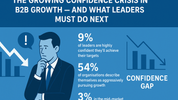The Customer Data Platform (CDP) industry is growing fast, with the industry expected to reach $1.5 billion this year. Still, this is a very small slice of the MarTech industry standing at $130 billion. Overall, this is great news because the prevalence of this technology will allow brands to prepare for the exponential explosion of data over the coming years and to meet their Big Data and DeepTech needs. According to Statista, the total amount of data consumed globally is forecast to reach 79 zettabytes in 2021. This is projected to grow to more than 180 zettabytes by 2025. To put this into context, 90% of the world's data was generated in the last 5 years and marketers will need to deal with 3 times more data than this in the next 5 years.

But while there are more marketing applications than ever on the market, marketing is more complex than ever before. The range of marketing solutions and their various applications can be confusing, with many MarTech companies building their CDPs with just their own views in mind.
Why We Need Customer Data Platforms
With advances in global communications and technology from 5G to IoT and CTV, we are experiencing an explosion of data we have never seen before. With this data piling up, the challenge for brands lies in managing it effectively. According to Futurum Research, 73% of companies say they will need new engagement models to help them leverage real-time data collection, analysis and activation to be effective in personalising content across all channels and devices.
Another challenge is getting access to this data in the first place. Tech giants such as Facebook, Google, Apple, and Amazon are taking a privacy-first approach, meaning they are only going to increase the height of their walled gardens. This will make it difficult for brands to communicate or measure their marketing effectiveness inside these walled gardens, further fuelling advertising business models. Only the most discerning of marketers will realise how to communicate effectively with their consumers in and through the walled gardens, cost effectively I must add!
As the amount of data continues to increase, so will the cost of cloud computing. The more brands interrogate their data with machine learning and artificial intelligence algorithms to make it more individualised for marketing, the more their cloud costs will spiral out of control.
Can the MarTech Industry Help?
Unfortunately, MarTech applications are moving to no-code environments, which are, by their very nature, oversimplifying the use cases marketers should implement. This oversimplification is counterintuitive because it means Marketing Operations (MOPS) need to manage many applications. And right on cue, the movement of head-less MarTech applications begins…
On average, marketers manage 97 applications, with each one streaming new data from a myriad of channels, devices, and internal applications into silos. This creates a data and security compliance nightmare! Marketers are left wondering where certain data is and can run into issues when asked to delete a record when a customer invokes their ‘right to forget’ or finding certain data if a regulatory body requests it.
With so many integration points connecting data silos and, in turn, team silos, this not only raises MOPS costs but makes it impossible to create a truly differentiating customer experience.
This is where CDPs come in. CDPs are attempting to solve the problems MarTech has created for marketers. Though, are they really solving the problem each unique business and marketer within them is trying to solve? Or, is it adding to the exact problem MarTech eco-systems have created for marketers - system clutter!
This leads to 42% of MarTech bought by brands going unused and 70% of marketing content created doesn’t see the light of day. With more than 50% of marketing budgets being spent on content and MarTech, how much money is quite literally being wasted? There’s no wonder only 18% of brands can measure the ROI from their MarTech stack.
According to David Raab of the CDP Institute; a CDP is defined as packaged software that builds a unified, persistent customer database which is accessible to external systems. Why stop there, why not include consumer data too? This very valuable 1st party data and often invisible media impression level data plays such a big part in customer acquisition and makes up for a very large percentage of marketing budgets.
But of the 87 platforms classified as CDPs today, and the several hundred other applications that are also calling themselves CDPs, it is apparent that none appear to ingest all consumer data (including all media consumption), in real-time and cost effectively. So how can CMO’s possibly measure marketing performance effectively, let alone understand the true ROI of their MarTech stack.
A CDP can mean different things to different people. Like with Customer Relationship Management (CRM) platforms 20 years ago, you can’t just hear the name and assume you know its core value proposition. There are many different categories of CDPs, and within these, there’s a spectrum of capability depending on the use case you need to deliver.
Core Competencies for a Customer Data Platform
A core consideration for a CDP is the ‘C’, which stands for ‘consumer’, not ‘customer’. This is an important distinction to make because you need to understand all of the impression data being collected at the top of the marketing funnel - being the content or ads your customers and prospects are not clicking on and what they are clicking on. A CDP needs to give you the ability to track, measure, unify, and activate all paid and owned media, even more so now that DMPs (Data Management Platform), as we knew them before, are coming to an end.
It also needs to put consent management at its core. With the ever-evolving privacy landscape, your consent management controls need to ensure your data capture management is automatically aligned with differing global and local legislation, policy, and laws.
Your CDP should also provide you real-time data. I don’t just mean for the occasional use case. I’m talking about it taking just a few milliseconds to bring your consumer profiles to life across your entire MarTech and AdTech ecosystem. By bringing the application to your data, you can realise a real-time, single view of your consumers, whether this is serving the MarTech or AdTech side of your business.
Another important aspect is data unification. Your data should be presented as heterogeneous and polymorphic as a baseline, especially because the average consumer uses multiple browsers in different locations across at least three devices in a single day and that behaviour will change over time. This is only growing with the update of CTVs, IoT, and Digital OOH.
You also need to have a CDP that lets you take ownership of creating your own 1st party identity graphs. This is especially important in the face of changes being made by big tech! Brands, at a minimum, should have the ability to give their customers what they want across all media, beginning with ‘unknown targeted with media’, ‘unknown engaging with owned media’, and, of course, their ‘customers’.
Your CDP needs to help you lower your cloud computing costs. As marketers, we can expect to be dealing with 50 times more data over the next five years. With customer experience giving brands a competitive advantage, there’s no hiding the fact that more data will need crunching. Why do you think Google, AWS and other cloud providers’ profits are climbing fast? It’s because we are interrogating data layers more aggressively than ever to deliver the 1-2-1 experience for our clients’ and their customers. If your CDP solution provider is not helping you to lower your cloud costs and increasing the speed of your computing, you should consider an alternative option given the direction our industry is going.
Finally, you won’t get the most out of a CDP if it doesn’t have the right analytics and attribution capabilities. The quality of the input dictates the quality of the outputs, and if true log level telemetry across all paid and owned media is not being fed in, you cannot expect the models or algorithms to do their job effectively. For example, you can only achieve true multi-touch media attribution with log level consumer data. You shouldn’t make decisions on your marketing performance when you don’t have the data you need to make an informed decision!
All of these competencies are the minimum viable capabilities that brands need to prepare for the future, and as marketing service and application providers it’s your duty to ensure you have the right technology to enable this.
Other Areas to Consider when Choosing a Customer Data Platform
There are also a few other competencies you need to consider within the application layer of your solution and stack. One is decisioning and personalisation. With a deep, real-time understanding of your customers, you can deliver highly personalised experiences. Other considerations include data activation, decisioning and orchestration, and machine learning and artificial intelligence. Honestly, the list goes on, and I’m sure it will just keep growing.
But really, as your business plans its product development strategy or considers which application service provider to partner with, it comes down to two main things.
First, your strategy must take into account the need to create a differentiated consumer experience for your client and their consumers. In the modern marketing landscape, a differentiated consumer experience isn’t just something that is nice to do, but consumers increasingly expect it. After all, customer experience is king. A positive customer experience can promote loyalty, customer retention, and brand advocacy and help a brand gain a substantial competitive advantage. It’s what will differentiate you from the competition - the several thousand technology and services companies competing for the same.
Secondly, with the rising complexity and cost in MOPS & SOPS your solution should compliment the existing ecosystem, not add to it. Your clients need a solution that does not disrupt their organisation like many MarTech applications before. This solution needs to complement their existing stack and operations to ensure low risk, quick wins, and a shorter time to market.
Be Prepared for the Modern Marketing World with Supero
AdTech and MarTech need DeepTech (aka MADTech) for brands to survive the next generation of marketing and you can help your clients by partnering with Supero. If you want to learn more about Supero and what we are doing to help advance the MarTech industry, please don’t hesitate to get in touch. Message me directly on LinkedIn, book a call.
~~~~~~~~~~~~~~~~~~~~~~~~~~~~~~~~~~~~~~~~~~~~~~~~~~~~~
Follow me on Twitter: https://twitter.com/Alex_Supero
Subscribe to my YouTube channel: https://www.youtube.com/@Alex_Supero (more to come!)
Join our community Walking Digital Corridors on Guild: https://guild.co/groups/5769/walking-digital-corridors?uid=f2cc5fb136
 unknownx500
unknownx500











